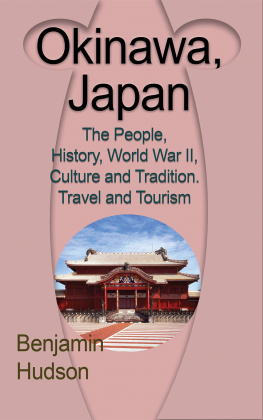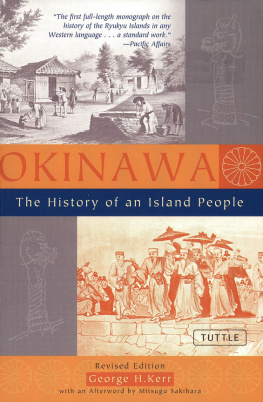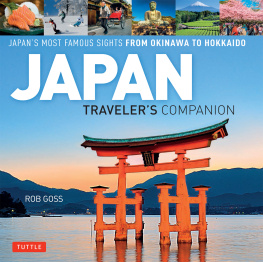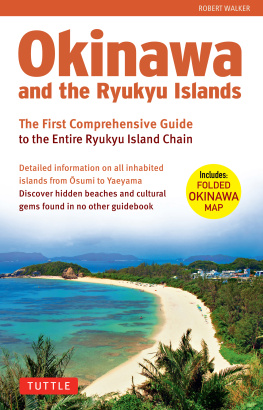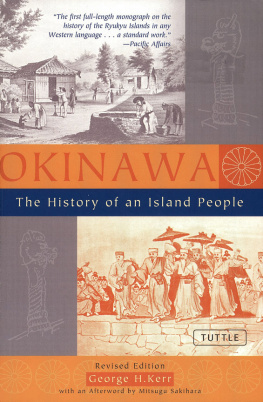Okinawa, Japan
The People, History, World War II, Culture and Tradition. Travel and Tourism
Author
Benjamin Hudson
Copyright Notice
Copyright 2017 Global Print Digital
All Rights Reserved
Digital Management Copyright Notice . This Title is not in public domain, it is copyrighted to the original author, and being published by Global Print Digital . No other means of reproducing this title is accepted, and none of its content is editable, neither right to commercialize it is accepted, except with the consent of the author or authorized distributor. You must purchase this Title from a vendor whos right is given to sell it, other sources of purchase are not accepted, and accountable for an action against. We are happy that you understood, and being guided by these terms as you proceed. Thank you
First Printing: 2017.
ISBN: 978-1-912483-36-5
Publisher : Global Print Digital.
Arlington Row, Bibury, Cirencester GL7 5ND
Gloucester
United Kingdom.
Website: www.homeworkoffer.com
Introduction
This book covers all parts of Okinawa Peoples life, including History, Environment, People, Tradition, Diet, and much more. Service interest: Self-Education, Travel and Tourism, Business purposes.
Okinawa was once an independent country which was ruled by the Ryukyu Kingdom, and flourished through trade with China - the largest country in Asia - as well as other neighboring countries. After the invasion of Satsuma in 1609, Ryukyu became a part of Japans shogunate system. It became a prefecture of Japan due to the Abolition of the Han System and Establishment of the Prefecture System, which occurred in 1879.
During the Pacific War, Okinawa was the site of the only land battle in Japan that involved civilians. After the war, Okinawa was placed under the administration of the United States. In 1972, however, Okinawa was returned to Japanese administration. Okinawa remains under Japanese administration today.
Okinawa Prefecture is the only region in Japan that is in the subtropical zone, and is blessed with a warm climate all year round. An ocean with coral reefs, where schools of colorful tropical fish swim about, sustains various forms of life.
In addition, creatures that are treasured worldwide, such as the Okinawa rail and the Iriomote cat, make their habitats in the forests of the northern part of Okinawa island and Iriomote island.
In December 2000, nine sites - including Shuri Castle Ruins and Nakagusuku Castle Ruins - were registered as world heritage sites and were named Gusuku Sites and Related Properties of the Kingdom of Ryukyu. It is said that there are nearly 300 gusukus (castles) in the Ryukyu Islands, many of which were constructed on slopes with scenic views. The gusukus that were registered as world heritage sites are believed to have been the residential castles of regional rulers who played an active role during the process of establishment of the Ryukyu Kingdom.
During the Ryukyu Dynasty, the royal government put a great deal of effort into developing performing arts, and royal performing arts such as kumiodori (a traditional narrative dance), buyo (a traditional dance), and music blossomed. Performing arts that were performed in festivals as well as those that were performed for amusement purposes by commoners also flourished, and are continued to this day. In recent years, the success of musicians and artists from Okinawa has received much attention.
In addition, Okinawa has a variety of traditional crafts including dyed textiles (such as bingata and bashofu), lacquerware, and earthenware, many of which were developed during the Ryukyu Dynasty through cultural exchanges with countries such as China and Japan. Okinawa has developed a distinct aesthetic beauty while being influenced by such cultural exchanges.
Okinawa has a variety of festivals for each season. The festivals range in variety and include: festivals for welcoming the spirits of ancestors, festivals for wishing a good harvest and abundant fish catches, and festivals for keeping away plagues. The regional flavors are also rich.
While we cherish traditional festivals, new festivals that incorporate Okinawan history, culture, and traditional performing arts, such as the All-Okinawa Eisa Festival and the Ryukyu Kingdom Royal Procession, have also been created.
Okinawa is one of the worlds leaders in longevity. Some of the factors that have sustained this longevity include: a warm climate, the easygoing personalities of the locals, the spirit of yumaru (helping one another), and the traditional food culture.As for the food culture in particular, the idea of healthy diet, healthy body has become widely accepted in Okinawa, influenced by cultural exchanges with China.
Okinawan cooking includes royal cuisine, which was developed to serve the Chinese emperors envoys or officials from Satsuma, and commoners dishes which were developed to suit the lives of common people.
History
Prehistory of Okinawa
Okinawa lies at the southwest tip of the Japanese archipelago and consists of a chain of a great number of islands. Presently the islands of Okinawa are sandwiched between the Japanese mainland and continental Asia but in ancient times they were connected to the Asian continent. There was migration from the continent by flora and fauna as evidenced by fossils unearthed in excavations.
It is not clear when humans came to inhabit the islands but fossil human bones from the Yamashita-cho Cave 1, excavated in Naha City, have been positively dated to 32,000 years ago and, in Gushigami-son village, the remains of the Minatogawa people have been dated to 17,000 years ago. These Paleolithic humans are thought to have crossed over on a land bridge from continental China but exact details remain unknown.
From the era of the Minatogawa humans there is a blank spot in our knowledge for about 10,000 years until the Neolithic era, around 7,000 years ago. This period in Japan extends through the Jomon Period (to 200BC) and is divided into the Early, First-half, Middle, Late, and Final Jomon Periods and as well as the Yayoi Period (200BC to 250AD). The Early and First-half of the Jomon period was one of thriving exchange between Okinawa and Kyushu. The middle period saw the development of independent cultures on the Okinawa and Amami Islands but the exchanges with Kyushu resumed in the Late Jomon. By the end of the Jomon, villages were forming and there appears to have been contact with China as well. These periods can be said to have been eras of active exchange with Kyushu.
In the Yayoi there are many remains in the coastal sand dunes where artifacts show trade with both Kyushu and China. Shells of Tricornis latissimus shellfish, used as raw material for making shell products, are typical of goods transported to Kyushu at that time. Aside from the earthenware brought in from Kyushu, the custom of burial in box-shaped stone coffins was transferred from Kyushu.
From the Kofun (Tumulus) era (250-552AD) through to the Heian Period (749-1185 AD), the society on the Okinawa and Amami Islands was in the hunter-gatherer stage and there was little contact with mainland Japan.
The Sakishima area, consisting of the Miyako and Yaeyama island groups, formed a different cultural sphere than the Okinawa and Amami island groups. There was no influence from the Jomon and Yayoi cultures and it is thought from existent remains that the Sakishima area had more in common with the southern regions of Asia.
The Paleolithic Age in Okinawa
The Origin of the Ryukyu Island Chain
To the east of continental China, the Ryukyu chain stretches out in the 1,200km between Kyushu and Taiwan. Around the middle of these southern islands is Okinawa Prefecture. The prefecture is composed of 146 islands looking across the vast East China Sea to the continent of China.

